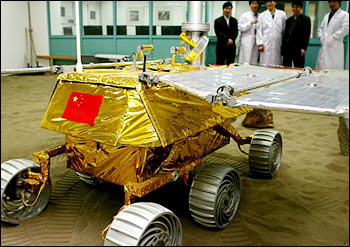Shanghai launched its prototype lunar rover, or remote-controlled vehicle MR-2, and has staked its hopes of being selected to take part in China's first moon landing in 2012, researchers announced over the weekend.

Saturday saw the remote-controlled vehicle MR-2 unveiled at a China-United Kingdom space technology seminar at the Shanghai Aerospace System Engineering Institute.
The rover, with a cruising speed of 100 meters per hour and evening out at 1.5 meters high and 200 kilograms, is inspired from America's "Spirit," which made its successful first run on Mars.
"We want to make it better than the early US and Russian rovers," institute director Luo Jian said, although he did not specify the improvements to be made.
Luo announced that the moon vehicle has been four years in the making at a laboratory kitted out to replicate the surface of Earth's sole moon.
The rover has the ability to capture three-dimensional images, transmit real-time motion pictures and perform instant digging and analysis of soil of samples. It can also climb inclines and is fitted with sensors to avoid obstacles.
Fine tuning is still ongoing to make sure the vehicle will withstand the moon's gravity, only one-sixth that of Earth's, and will be able to function despite cosmic rays, solar radiation and vast temperature swings between -180 degrees Celsius at night and 150 degrees in the day. The institute will improve its laboratory to simulate moon-like gravity conditions and give it the ability to bombard the rover with cosmic rays to round out its testing.
Power generation remains a thorn in the engineers' side since solar power could be problem on the moon due to its long nights, lasting 14 Earth days. A solution could be provided by a nuclear power source which will allow the rover constant power during its voyage 380,000 kilometers into space.
Space institutes in Beijing and around China are also working on their own rovers with China's central space authority still not revealing when the final selection will be made.
The country's lunar ambitions fall under the aegis of the "Chang'e Project," named after the Chinese moon goddess. I It comprises three stages through 2017.
Made up of three stages, the project will first see a lunar orbiter launched later this year to be followed by a remote-controlled lunar rover in 2012 and an unmanned return module will follow.
Following this, preparations are underway for a manned lunar trip after 2017.
(Shanghai Daily April 2, 2007)
